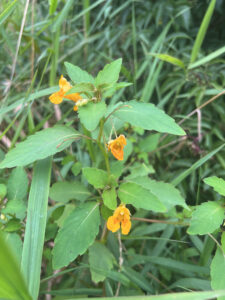Summer’s Not Over Yet

By Kate Carnahan, Outdoor Recreation Specialist Individual Placement / AmeriCorps Member placed at Minnesota Department of Natural Resources, Division of Parks and Trails
It’s August: the sun is blazing hot, the bugs are running rampant, the algae is blooming in the lakes, and all you want to do is stay inside and let it pass. Maybe some of you have even started to prepare your fall décor of pumpkin themed wall hangings and autumnal toned linens. Well before you start making the transition into fall and skip soaking up the last moments warm ‘sota summers, there are a few beautiful wildflowers that have been waiting all year for this month.


First would be the most well-known friend of Monarch Butterflies, Common Milkweed (Asclepias syriaca). This plant can be identified by ovular and opposite leaves with pink umbel (think sphere-like) flower formations that attract many pollinators. These flowers are vital to the survival of Monarchs as they exclusively eat this plant when caterpillars and lay their eggs on the plant as adults. They can be found in fence rows, roadsides, fields, prairies, and pastures. In the fall they will form seed pods that contain hundreds of hairy seeds that will be picked up by the wind and blown across their habitat. Considering the declining Monarch Butterfly populations, this may be one of the most important plants to look out for this month.

Another plant beginning to flower would be New England Aster’s (Symphyotrichum novae-angliae), known by their clasping leaves and hairy stems that lead to stunning deep violet flowers around yellow central flowers ones. They can grow in a wide variety of soils, and so can be found in fields, shorelines, prairies, and meadows. They are especially useful to pollinators as a source of pollen later in the season. Traditionally, New England Asters were used by indigenous communities for a varieties of ailments like fevers, pain relief, and catarrh. They begin to bloom in August and will last through October.

Lastly, Spotted Jewelweed (Impatiens capensis) can be found in moist, shady forests across the state. Also known as spotted “touch-me-not”, this plant is described as having long, tube-shaped orange flowers decorated with red-orange flecks and seed pods that pop open when touched, hence the name. They typically start blooming in July and reach maximum size by August, where they will last until the frost kills the plant in the fall. It can be aggressive in its favored habitats, therefore making it a strong competitor against invasive Garlic Mustard (Alliaria petiolate). It can also act as a natural remedy to poison ivy exposure if caught quickly enough. As soon as you realize you were exposed, remove a few leaves from Spotted Jewelweed and begin crushing them in your hand. Once you feel the sap release, rub the leaves on the affected area. Of course, once you reach an area where you can properly wash the skin with oiled soap and hot water please do so—but it’s still a good trick to know when you’re hiking or away from facilities!
So, before you start packing up your beach balls and move into Pumpkin Spice Latte season, remember that summer isn’t over yet for you or your native wildflowers—all you must do is get outside and find them!
Sources:
Minnesota Board of Water & Soil Resources